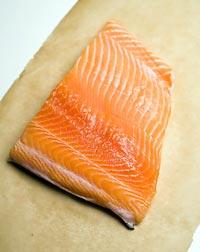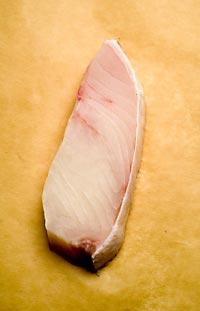Originally published February 21, 2007 at 12:00 AM | Page modified June 26, 2007 at 2:32 PM
Cooking School
A flair for picking fish
The brightly lit seafood case is stocked with glossy fillets of salmon and halibut, and loins of albacore and yellowfin tuna waiting to...
Seattle Times Food staff
The brightly lit seafood case is stocked with glossy fillets of salmon and halibut, and loins of albacore and yellowfin tuna waiting to be sliced into serving-size pieces. A display of silvery whole salmon, covered in a thick layer of ice, fronts the case, and there's a fresh smell in the air.
That's the first tip-off that this particular seafood vendor is serious about his trade. But it takes a trained eye to determine which of the choices before you really are the best. With the season of Lent beginning today, it's a good time to brush up on the most basic signs of quality.
For the consumer, labeling can be confusing and doesn't necessarily have anything to do with the quality of the seafood.
"This is a very complicated subject," said Jon Rowley, who has been affiliated with the seafood industry for more than 30 years and has witnessed firsthand the changes in how our fish is handled.
" 'Flash frozen' implies it is frozen quickly, which is a good thing, but then the fish needs to be in excellent condition prior to freezing for it to come out right," said Rowley. "It is possible to produce very good frozen fish if you start with someone who knows how to do it, you start with impeccable quality fish and have the right equipment."
And according to Rowley, terms such as "fresh frozen" don't tell us anything about quality.
The knowledgeable customer is the most reliable guide to selecting quality seafood.
There are many indicators to watch for when tracking down the freshest seafood, and it doesn't take long to train the eye. (See our accompanying guidelines for choosing fillets and steaks, as well as whole fish.) It's easy to determine the freshness of a whole fish, for instance, if the head is intact. "If it looks alive, with clear eyes, moist and shiny skin, and Christmas-red- colored gills, it's fresh," writes Fred Thompson, author of "The Big Book of Fish & Shellfish" (Chronicle Books, 2006).
If the head is removed, it may be a sign that the fish is older.
"Fillets and steaks, too, should be moist looking and have sharp color for the type of fish but look a little translucent," continues Thompson. "Ask to smell the fish. Does it smell like the sea? Ask the fishmonger to touch the fillet and see if the flesh springs back, meaning it is firm, another positive sign. Fish and fillets bruise just like we do, so look for discolored spots on the flesh. Brown and gray spots are signs of age, so pass on these."
Even the day of the week is a consideration when picking out seafood. Sunday may not be the best day, but "it's not as bad as Monday," said Rowley. Often the freshest fish hasn't come in from the supplier, or it comes in later in the day and the fishmonger hasn't had a chance to prepare it for selling.
For a main dish, count on buying about 6 ounces of fillet or steak per person, and 12 ounces of whole fish. Before leaving the store, ask the vendor to pack the fish in ice if you're not returning home within 30 minutes.
![]()
Once home, "all fish, whether fillets and steaks or whole fish, should be unwrapped and released from their packaging," said Dale Erickson, owner of University Seafood and Poultry Co. in the University District. "The foul air that collects can produce bacteria quickly."
He suggests covering the fish with a wet tea towel or loose piece of plastic wrap, refrigerating it, and eating it within a day or two of purchase. "Quality seafood is not meant to be stored," said Erickson.
If the fish is frozen, Rowley recommends thawing it slowly in the refrigerator. The thawing time will depend on the size and thickness of the fish, although fillets and steaks should be ready for cooking within about 8 hours. (For food safety, do not thaw fish at room temperature.)
"If it leaks a lot of water when defrosted it's been mishandled during the freezing process and will be drier when cooked," said Rowley. If buying fish wrapped in cellophane, make sure there's no visible liquid in the package.
Twenty years ago, quality seafood was difficult to find in the Northwest supermarkets. Now, "it's possible to find good fish in groceries, as long as the customer knows what to look for," said Rowley.
In the end, suggests Rowley, "Buy the fish that speaks to you, that tells you it's fresh and ready to be eaten."
CeCe Sullivan: csullivan@seattletimes.com
NEW - 10:07 AM
Obese people asked to eat fast food for health study
Seattle Beer News | Brouwer's Hard Liver Barleywine Festival kicks off this Saturday
Organic advocates voice concern for 'natural' food
Taste: Muffuletta sandwiches are the Big Easy's best
NEW - 7:00 PM
Wine Adviser: Some good Washington wineries got away

Entertainment | Top Video | World | Offbeat Video | Sci-Tech
general classifieds
Garage & estate salesFurniture & home furnishings
Electronics
just listed
More listings
POST A FREE LISTING






